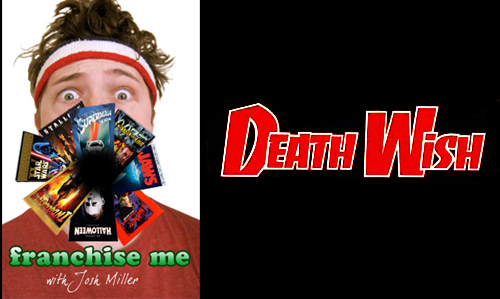
Hollywood loves a good franchise. The movie-going public does too. Horror, action, comedy, sci-fi, western, no genre is safe. And any film, no matter how seemingly stand-alone, conclusive, or inappropriate to sequel, could generate an expansive franchise. They are legion. We are surrounded. But a champion has risen from the rabble to defend us. Me. I have donned my sweats and taken up cinema’s gauntlet. Don’t try this at home. I am a professional.
.
The Franchise: Death Wish — following the on-going killing spree of Paul Kersey, a liberal pacifist architect who is transformed into a gun-toting vigilante after his family is attacked by muggers. The series stretched over five films from 1974 to 1994.
The Installment: Death Wish (1974)
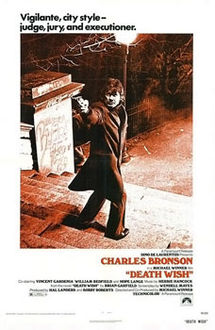
Punks Dealt Bronson Justice: 8
The Story: Paul Kersey (Charles Bronson) is a happy family man, with a lovely wife, Joanna (Hope Lange), and a daughter, Carol (Kathleen Tolan). He’s an architect with liberal views and sympathy for the lower classes. He’s also a pacifist who hasn’t touched a gun since childhood, and was a conscientious objector during the Korean War. But everything changes when Joanna and Carol are followed home from the grocery store by three dirty punks (one of whom is a young Jeff Goldblum) who beat and rob them. Joanna dies and Carol is so traumatized she becomes catatonic. When Kersey is given a handgun by a business associate as a present, the former pacifist finds new purpose blowing the shit out of muggers on the street. Referred to by the press as “the vigilante,” Kersey becomes a major problem for the NYPD, and the investigator in charge of the case, Lt. Frank Ochoa (Vincent Gardenia).
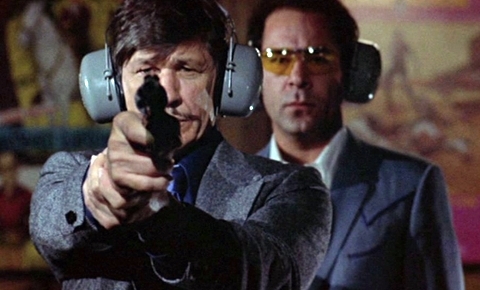
What Works: Pretty much everything. This is one of the greats in gritty street-crime exploitation cinema, mainstream or otherwise. Though obviously existing in the influential wake of Dirty Harry, Death Wish started its own subgenre – the citizen vigilante – not to mention Charles Bronson forming his own cottage industry within that subgenre. And though Bronson isn’t what makes this film, he is obviously a major factor. 53. That’s how many motherfucking years old Bronson was when he made this film, which is pretty amazing when you consider that there are twenty more years left to this franchise. But his age works wonders for the material. Of the box office action stars at the time, I’m not sure any would have been as effective as Bronson. The film is based on a novel by Brian Garfield (who apparently hated the film), and was originally going to be directed by Sidney Lumet with Jack Lemon as Kersey, and I think that almost-was casting certainly paints what kind of character Kersey is. He’s not an Eastwood or a McQueen. And while Bronson was obviously a manly man (the film’s opening beach scene demonstrates his impressive state of fitness), his fleshy face, droopy eyes, and compounding age give him a very un-movie-star look. I buy him as just some dude long enough to make his transformation into vigilante badass feel almost surprising. And then of course there is Bronson’s weird oft-parodied speaking voice, which makes every other line he says immediately quotable even if there is nothing particularly interesting about the content of what he just said. Just hearing him say “No” puts a smile on my face.
The other stand-out performance of the film is Vincent Gardenia as Lt. Ochoa. Ochoa is a great character. I love that he’s neither corrupt nor do-gooder. He’s determined to find the Vigilante, and is quite clever about it. But the moment City Hall says they don’t want the Vigilante arrested, Ochoa says, “Sure. You’re the boss.” He won’t kill the Vigilante, but he’s more than happy to ask him to leave town. It is a very believable balance for the character to have. And Gardenia makes you love the man, with his droll delivery, bemused bearing, and periodic sneezing.
The score by Herbie Hancock is, well, a score by Herbie Hancock. That’s something in and of itself, especially in 1974. Part jazz, part funk, part traditional score, it is all mid-70’s awesome.
Speaking of the 70’s, even though the factor of my age will always leave me with a proclivity for 80’s genre and action cinema, I love the tone of 70’s crime films. The firm roots these films have in the naturalistic stylistics and realistic character sketches popular at the time always makes their departure from reality all the more fun. Death Wish is a ridiculous movie. The heightened level of crime and the absurd behavior of the criminals is laughable, yet set against the otherwise respectfully authentic details of the film it works in a beautiful harmony of movie yumminess.
I don’t think Michael Winner is anything more than a quality journeyman director, but he handles the material well and makes some good aesthetic choices (unless you prefer Garfield’s novel, I suppose). I particularly liked the bleak snow storm setting for Joana’s funeral, which is then nicely off-set by Kersey’s trip to sunny Arizona. And Winner certainly doesn’t shy away from brutality. The attack on Joana and Carol is almost baroque. One of the punks is casually, rather absentmindedly spray-painting graffiti in the Kersey apartment while the other two brutalize the two women. This culminates in the indelible image of Carol getting her bare ass spray-painted. It is such a weird moment. Almost funny. Actually it is funny, but then that’s what makes it so effectively disquieting. Winner understands that we need to hate these guys and what they did to be able to support Kersey turning to the dark side. And though the moment really belongs to Bronson, I loved the small but meaty moment when Kersey freaks out – releasing all his adrenaline – alone in his apartment after bashing a mugger in the face with a sock full of quarters. That’s some good Bronson right there.
Thematically, I love the film’s allegorical relationship to Westerns. When Kersey is in Arizona he witnesses an ‘Old West’ tourist show recreating a foiled bank robbery. As Kersey watches the actors playing “good guys” gun down the actors playing the robbers, the look on Bronson’s face tells us a million things. A switch has been flipped and as the film progresses we realize Kersey is now living out a cowboy-justice fantasy in the streets of New York. Though the film doesn’t directly address it, Kersey has gone batshit crazy. This finally rises to the surface when, badly injured, Kersey demands that a punk “Draw.” It also feeds into the amazing ending of the film, when Lt. Ochoa tells Kersey he needs to leave New York permanently, and Kersey smirks excitedly, asking, “Inspector… By sundown?” Speaking of the amazing ending, the final shot of Death Wish practically makes the entire movie. We think Kersey is going to go to Arizona, as the location has been mentioned repeatedly throughout the film, but then we cut to him arriving in Chicago. Kersey happily watches a gang of punks harass a young woman. If there was any doubt as to whether the look on his face was joy, when the punks make lewd gestures towards Kersey while he’s helping the woman pick up her belongings, Bronson makes this face…
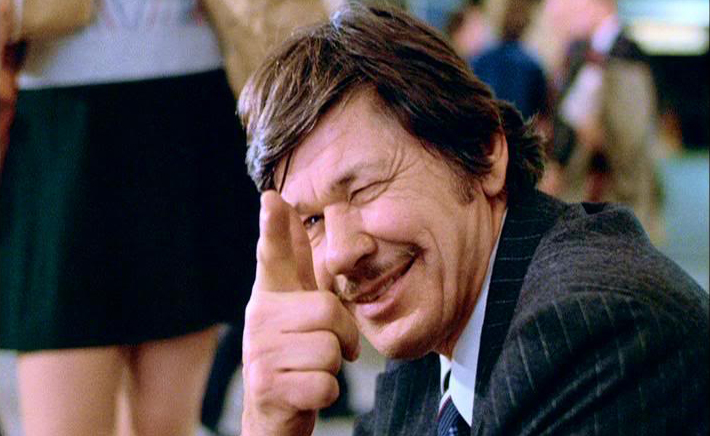
…letting us know that the ‘Old West’ is now alive in Chicago. He’s basically become The Punisher.
What Doesn’t Work: It’s hard to say anything “doesn’t work,” as Death Wish is one of those warts-and-all films that is made even more fun by its flaws. But it certainly isn’t perfect. The threat level of New York is established somewhat hamfistedly, and the criminals themselves are all cartoonishly over-the-top. At no point do Goldblum and his flunkies feel like real people. Their behavior is too heightened, which inherently renders everything they touch with a thick B-movie feel. None of the punks in the film feel very believable. For one thing, the entire city knows there is a vigilante going around shooting muggers, yet none of the muggers seem aware of this. Even just a small hint of their awareness would have gone a long way towards establishing the reality of this world. But none of this ever threatens to sink the film.
The only aspect of the film I found legitimately lacking or problematic was Carol. My suspension of disbelief was wildly strained by her catatonic state. I make no claims that I’m an expert on trauma, and I know cases of military “shell shock” do exist, but I just didn’t buy it within this context. As silly as the film could be at times, this was too B-movie melodramatic for me. Getting beaten up turned her into a vegetable? Even if that can happen, I wouldn’t have put that in the film. A lot of things can happen. I found myself wishing that Carol had just died to make things simpler.
The most bizarre aspect of this film is that Kersey never encounters or even tries to track down the three muggers who killed his wife. This, I think, is one of the many things that makes the film unique and interesting, but this may have something to do with why novelist Garfield didn’t like the film, because Winner and Bronson definitely paint Kersey in a strong hero light, but the abstract execution of his vengeance removes any semblance of moral justice from his actions (I have to assume Garfield painted a less noble and cheer-worthy Kersey). Really, if we’re analyzing this, Kersey just becomes a total psychopath. I wonder if the title Death Wish made more sense in the novel. In the film Kersey doesn’t have a death wish – that would have been an entirely different concept for a film. He wants to kill people, and he wants to keep staying alive so he can kill more people. Objectively the film probably should’ve been called Vigilante or something. Anyway, nothing in this paragraph is actually a criticism of the film. Merely me musing.
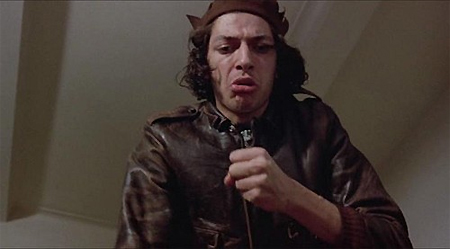
Most Egregious Punk Moment: Definitely the ass spray-painting.
Most Egregious Bronson Moment: The first time he chases down a punk and shoots them in the back. That’s when Kersey officially crosses the line.
Best Punk Dialogue: “Cunts! I kill rich cunts!” Said by Jeff Goldblum to Joanna Kersey.
Was Justice Satisfactorily Handed Out: Not at all. Goldblum and his two buddies are probably still out there spray-painting girls’ asses right now.
Should There Have Been A Sequel: That ending really gooses the idea of one, leaving things extremely open-ended. Definitely feels like there is more to tell of Kersey’s journey.
Up Next: Death Wish 2
.
previous franchises battled
Leprechaun
Tremors
Critters